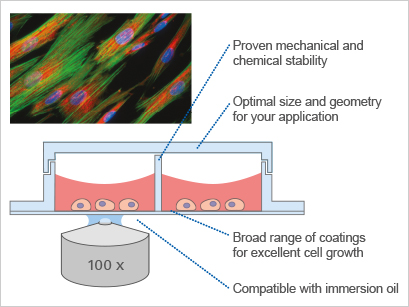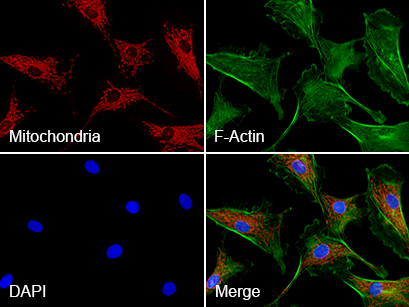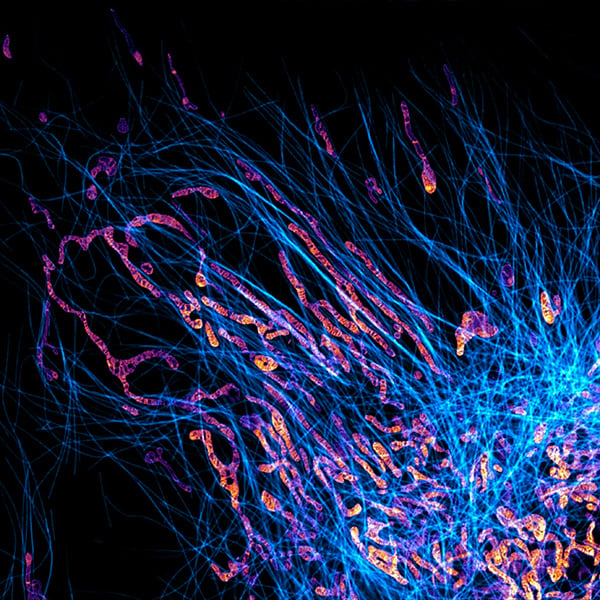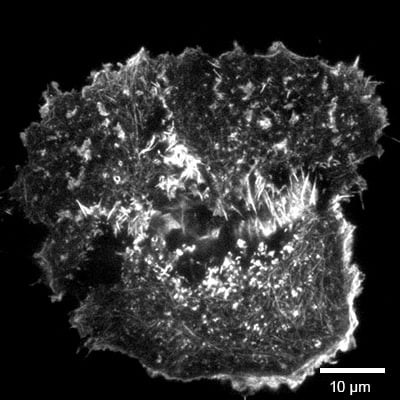The Coverslip Bottom
The outstanding characteristic of the ibidi µ-Slides, µ-Dishes, and µ-Plates is their thin coverslip bottom, which has excellent features for high-end microscopy applications. In comparison, the bottom of standard cell culture plastics is about 1 mm thick—which is more than 5 times the thickness of the coverslip and therefore not ideal for imaging.
ibidi offers labware with the ibidi Polymer Coverslip bottom or the ibidi Glass Coverslip bottom. For most applications, the ibidi Polymer Coverslip is the material of choice, as it offers optimal cell adherence combined with excellent optical properties. If your cells require a special coating, or if you are using a particular microscopy technique such as TIRF or super-resolution microscopy (STED, STORM), we recommend using the ibidi Glass Coverslip bottom.

Imaging chambers with the coverslip bottom are optimized mainly for use with inverted microscopy. You can find information about the compatibility of the surface materials with different microscopy techniques in our Surface Material Guide.
ibidi Blog Article |
Do you want to know the full story about the ibidi Polymer Coverslip, including its discovery, as well as optical and cell culture properties?
Find out in the ibidi Blog article More Than Plastic: The ibidi Polymer Coverslip by Tina Freisinger (ibidi GmbH).
 |  |  |  | |
| #1.5 ibidi Polymer Coverslip | #1.5H ibidi Glass Coverslip | #1.5 glass coverslip | Standard glass slide* | |
| Bottom thickness | 180 µm (+10/–5 µm) | 170 µm (+/–5 µm) | 170 µm (+20/–10 µm) | 1 mm |
| Bottom material | Polymer | D 263 M Schott high precision glass | D 263 M Schott high precision glass | Glass |
| Gas permeability | Yes | No | No | No |
* With the 3 Well | 8 Well | 12 Well Chamber Slides, removable, ibidi provides self-adhesive, removable silicone chambers that are mounted on a standard glass slide. They are suitable for upright and inverted microscopy and enable long-term storage of samples after immunofluorescence staining.
The ibidi Polymer Coverslip, which is our most recommended surface, is a thin plastic coverslip that forms the bottom of most μ-Slides, μ-Dishes, and μ-Plates. With a standard No. 1.5 coverslip thickness of 180 µm (+10/–5 µm) and immersion oil compatibility, it meets all optical requirements for microscopes and is suitable for various imaging techniques (e.g., phase contrast, DIC, widefield fluorescence, confocal microscopy, two-photon microscopy, FRAP, FRET, FLIM, or LSFM). Unlike glass, the ibidi Polymer Coverslip is gas-permeable. The ibidi Polymer Coverslip provides optimal growth conditions for various cell-based assays and cell types and is available with different treatments or coatings (ibiTreat, Bioinert, Collagen IV, Poly-L-Lysine). You can find more information about the coatings in our Coating Guide.

ibidi offers specialized glass bottom labware with a borosilicate coverglass bottom. ibidi developed these glass surfaces specifically for TIRF, super-resolution microscopy, and single molecule microscopy. The glass bottoms are completely gas-proof and do not allow for any gas exchange.
To provide the highest quality necessary for modern, high-precision microscope objectives, only D 263 M Schott glass coverslips with a thickness range of 170 μm (+/–5 μm) are used. This thickness is also known as #1.5H (high-precision).
The ibidi glass bottom labware is available in the following formats:
- µ-Dish 35 mm, high | µ-Dish 35 mm, low Glass Bottom
- µ-Dish 35 mm, high Grid-50 | Grid-500 Glass Bottom
- µ-Slide I Luer Glass Bottom Family
- µ-Slide VI 0.5 Glass Bottom
- µ-Slide 1 Well | 2 Well | 4 Well | 8 Well high| 18 Well Glass Bottom
- µ-Slide 2 Well Ph+ | 4 Well Ph+ Glass Bottom
- µ-Slide 15 Well 3D Glass Bottom
- µ-Plate 6 Well Glass Bottom
- µ-Plate 24 Well Glass Bottom
- µ-Plate 96 Well Square | Round Glass Bottom
- µ-Plate 96 Well 3D Glass Bottom
- µ-Plate 384 Well Glass Bottom

The image shows a part of a live cancer cell captured using a stimulated emission depletion (STED) super-resolution fluorescence microscope (Abberior Expert Line STED) with a UPlanSApo 100x/1.40 oil objective. The cells were labeled for mitochondria (orange) and the cytoskeleton (microtubules, cyan). Cells were cultivated and imaged in a μ-Dish 35 mm, high Glass Bottom. Image courtesy of Till Stephan, Buchmann Institute for Molecular Life Sciences, Goethe University Frankfurt, Germany.

TIRF image of MCF7 cells stably transfected with LifeAct, captured using a 100x oil immersion objective. Image courtesy of Lena Prange, AG Wedlich-Söldner, Institute of Cell Dynamics and Imaging, University of Münster, Germany.

The ibidi Glass Bottom Dish 35 mm is produced by using a standard #1.5 glass coverslip with a thickness of 170 µm (+20 µm/–10 µm). This glass bottom material fulfills the needs of all standard applications where a cost-effective coverslip is required.
Please note:
In principle, glass bottoms are suitable for direct cell culture. However, to promote cell attachment, a surface coating might be required prior to cell seeding.
Fun Fact: Why So Many ibidi Products Have a "µ" in Their Names
µ is a lowercase letter in the Greek alphabet ("Mu"). In the metric system, the unit prefix "µ" is used as a symbol for "micro" and represents one millionth (10-6).
Here are some reasons why the µ found its way into so many ibidi product names:
- Typically, eukaryotic cells are 10–100 micrometers in diameter.
- To put the cells into focus, we offer solutions for different microscopy techniques.
- The principle of the ibidi µ-Slides, µ-Dishes, and µ-Plates is the thin coverslip bottom with a thickness of 180 micrometers.
- Last, but not least, our physicists love to use Greek letters such as "µ".
Read on and learn more about the ibidi Chamber Surfaces or the Chamber Geometry.
Find Out More
Contact us for a printed version or download the posters "Microscopy With ibidi" or "Choosing the Best Microscopy Labware" as PDF.







